¥100 Banknote, Featuring a Dude with a Forked-Beard
Hello Silver & Gold stackers! Another week and I have another Japanese coin.... er... Japanese banknote for you! That's right, we are doing things a little different this time around. I've had this older banknote for awhile, but a friend recently asked me about it so I find it on my mind. I thought I'd share and you guys might enjoy. But don't worry, I'll include coins in the post as well, so we will get our silver allotment!
The banknote in question is this one
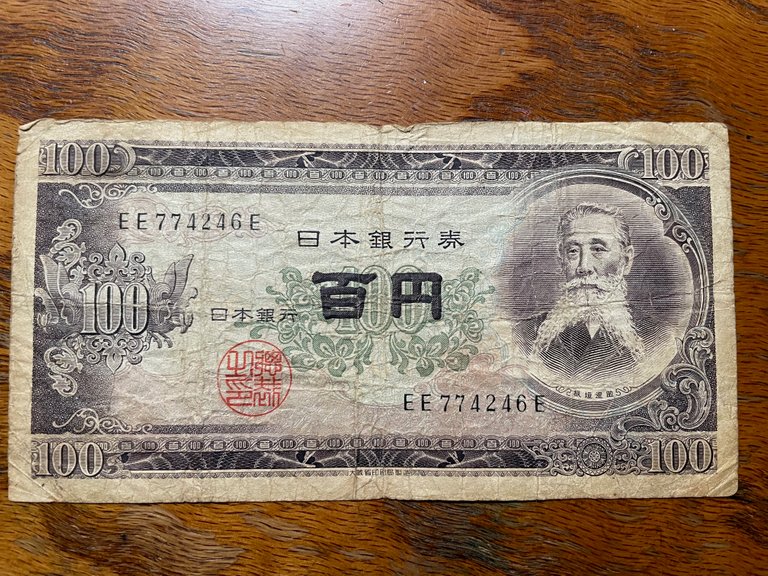
Let's explore!
Stats
It measures 148 x 76 mm. And... Hmm... guess that's the only stat. On to the next section!
Front Side

It has a face value of 100 yen, or 百円 (hyaku en) in Japanese. There are lots of nice design elements. Among them, you can see two phoenixes on the left side. This is a design from the main hall of Horyuji Temple.
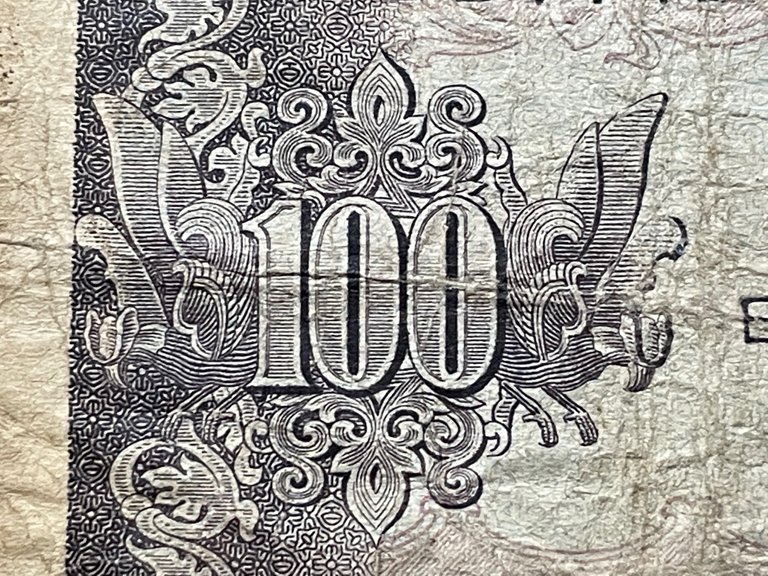
In the center we have 百円 which is 100 yen. This is the first ¥100 note to use the new simplified kanji for yen 円 instead of the older one 圓.
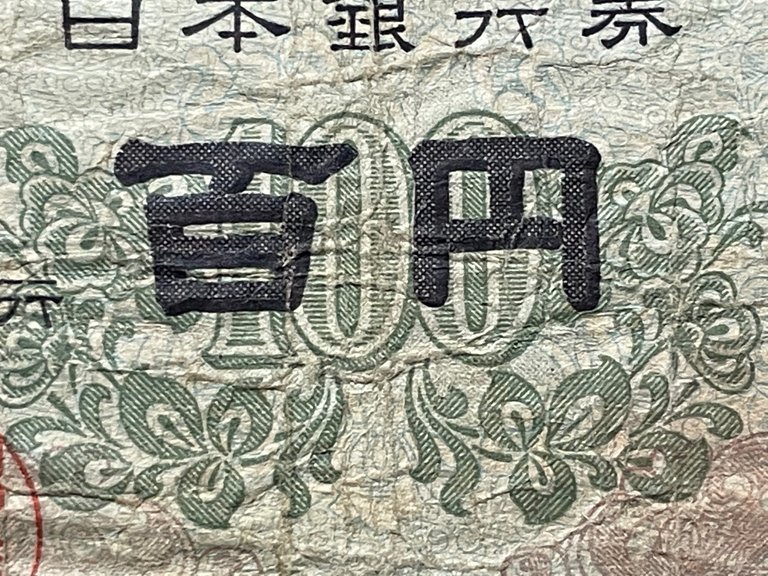
I'm not sure what the vines are in the center background. I see groups of three leaves and flowers of three or four petals. Not sure what that is but it looks nice. The word I keep finding on Japanese sites is hōsoge which is an floral pattern, so I suppose this is just a nice design and not any specific flower.
There is a strip of alternating 100 and 百, which means 100, along the top and bottom.
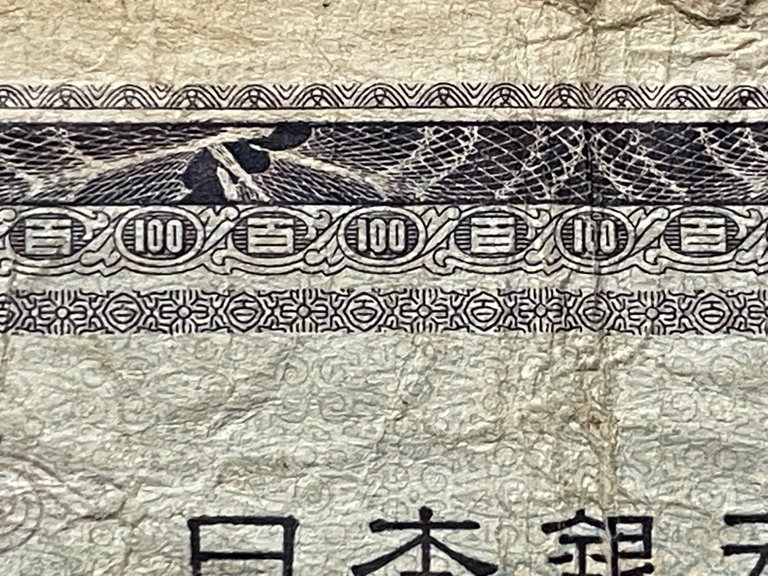
For the text we have 日本銀行券 (nippon ginkō ken) slightly above center. This translates to Note of the Bank of Japan.
Slightly left of center we have 日本銀行 (nippon ginkō), "Bank of Japan".
At the very bottom we have 大蔵省印刷局製造 (Ōkura-shō Insatsu-kyoku Seizō), "Manufactured by the Finance Ministry Printing Bureau".
That red stamp... I can't read. I would assume it's the personal seal of whoever was the head of the mint at the time this was printed.
Then we have this cool cat:
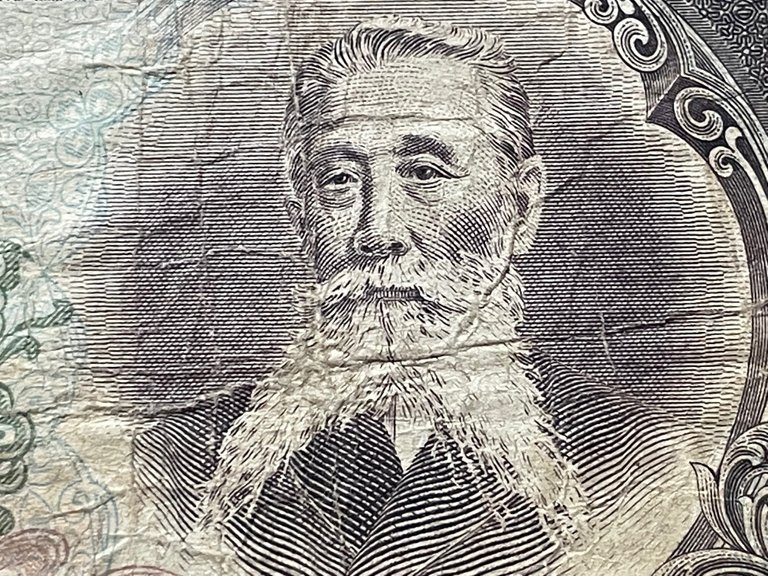
Below is his name, 板垣 退助, "Taisuke Itagaki". I'll give more info on him below, but for now just enjoy his spiffy image.
Back Side
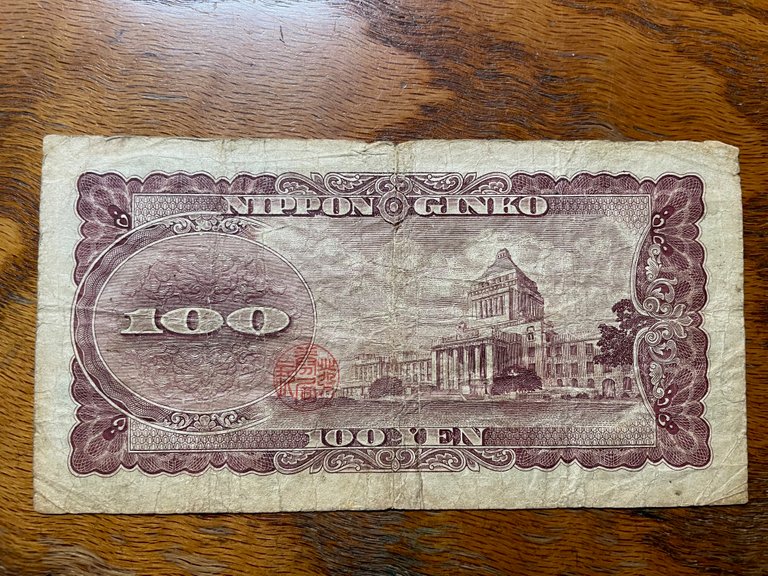
This side is a nice image of the national Diet building in Tokyo where both houses of Parliament meet. Mostly all latin script on this side. 100, 100 yen, and Nippon Ginko which means "Bank of Japan".
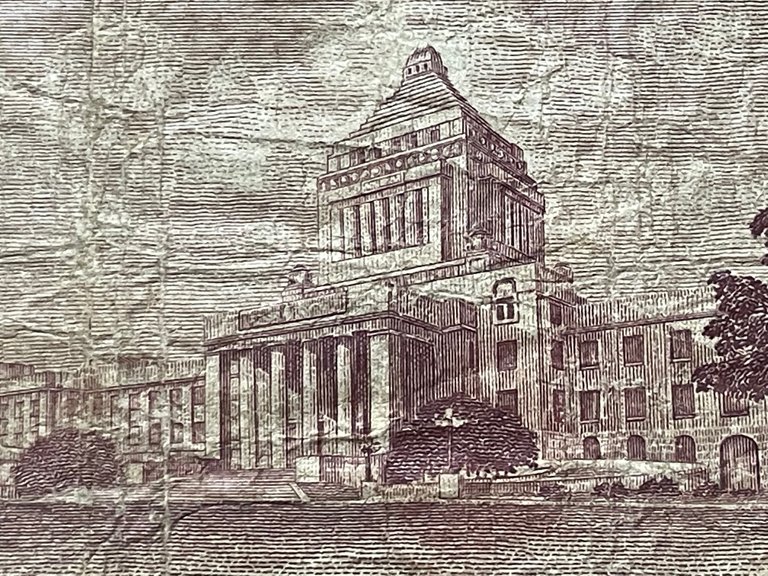
Another personal seal, from someone else this time.
Not quite as nice with the design flourishes as the front, a little simpler, but still nice enough.
About
This design was issued from 1953 to 1974 so it's not terribly old, nor valuable. My wife's parents say they remember using it when they were kids. I'm not enough of a collector to know what year this one I have was issued in. This was, however, the final ¥100 banknote to be issued. After 1974, it was coins only.
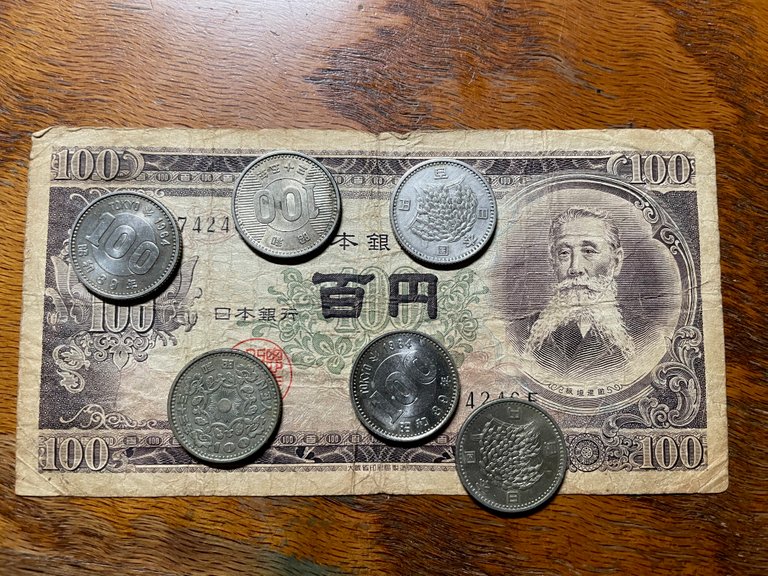
¥100 coins had been around since 1955, but they were never as popular as the banknotes. But these old coins, at least the ones from before the silver was removed in 1965, are worth much more than the banknotes today.
That fellow on the front, Taisuke Itagaki, besides having a pretty impressive forked beard, a style that is probably not going to come back into fashion anytime soon, was a pretty big name in politics and is today thought of as one of the most influential figures in modern Japanese history.
Briefly, he was born into a samurai family in 1837, during the last years of the Tokugawa Shogunate. For any not clear on old Japan, samurai were the upper class. By his time, few samurai actually fought, so get rid of that image. He joined the government of his domain until the revolution that toppled the Shogun government. During that war, he joined the right side and was rewarded with a place in the new Meiji government. But, having been very influenced by Western ideas of liberalism, he opposed a lot of what was going on in the new government and was a fierce advocate of setting up a constitutional government. He quit the government and founded what would eventually develop into Japan's first political party.
Well, that's the simple version anyway. He was an interesting guy. And he had an odd beard.
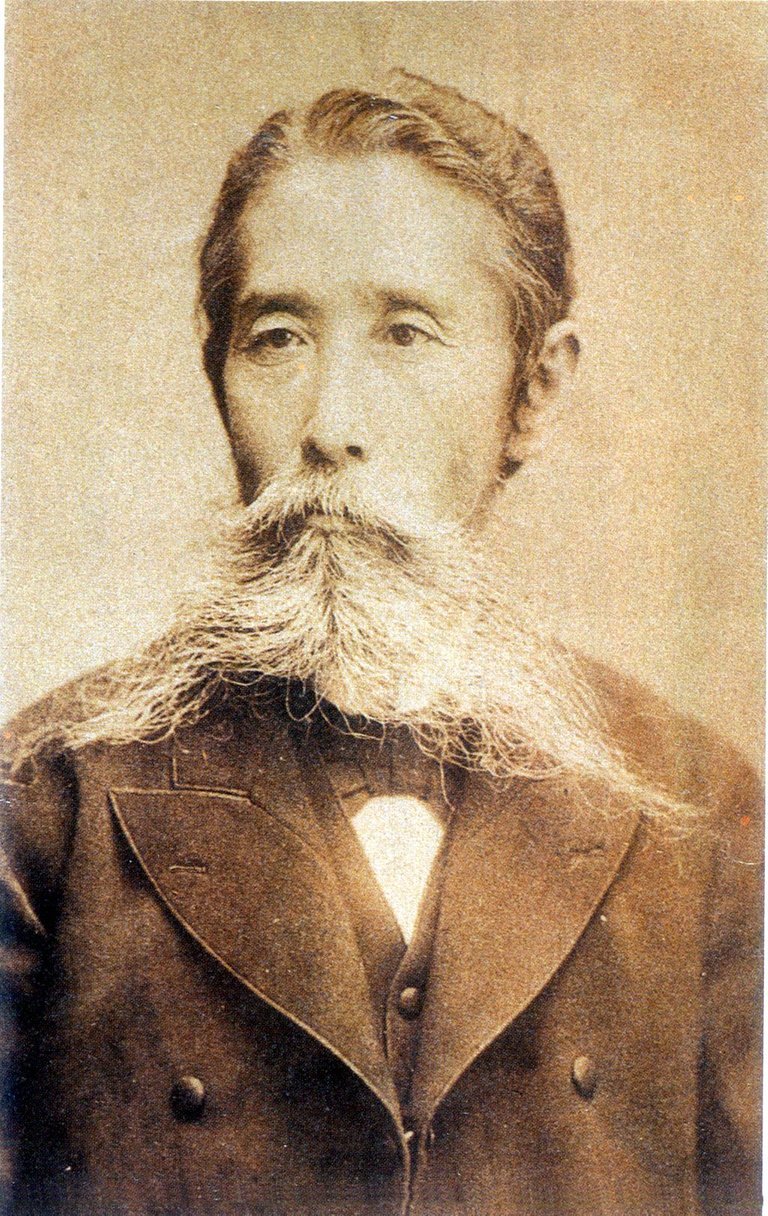
Overall
I know the ¥100 banknotes were more popular than the ¥100 coins, but I don't know if it was similar to the US where it's actually somewhat difficult to get your hands on $1 coins, so you end up using $1 bills by default unless you actually go to the bank to ask for the coins directly. I asked my in-laws, but they say they don't remember, they just remember using the notes more often.
So I looked up some data and it looks like ¥100 banknotes were printed far far more than coins. For example, in 1970, 205 million ¥100 banknotes were printed. In the same year only 3 million ¥100 coins were minted. Now I'm sure part of that overprint of the notes is because notes only last a few years before they fall apart, unlike coins which can last far longer, but yeah, it was probably harder to find ¥100 coins while the banknote was around.
I can't find any numbers prior to 1970, but given that silver was removed from the coins in 1967 in part because the value of silver had been rising beyond face value of the coins and people were melting them down, we might guess that it was even more difficult to find ¥100 coins before 1967, at least for the years leading up to it being removed when the price of silver was rising.
The Japanese wikipedia page (here) also mentions that the notes were much more popular than the coins, and also that so many were in circulation that tons of them survive. A total of 12,270,200,000 were printed over the years. So again, there is no value here. It's just a historic curiosity at this point.
Interestingly, the government first decided to end production of the banknote in 1966, but it wasn't until 1974 that they actually did it. And you thought your government worked slowly!

At any rate, I know we are all about silver and coins in this group, and I certainly have plenty of those silver ¥100 coins. But sometimes banknotes are also cool.
Hope you guys agree!
❦
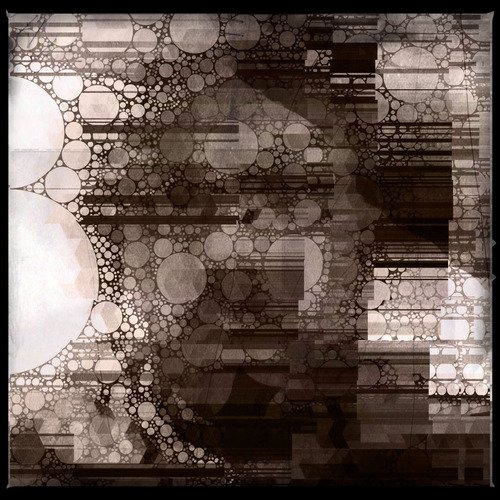 |
David LaSpina is an American photographer and translator lost in Japan, trying to capture the beauty of this country one photo at a time and searching for the perfect haiku. |
You received an upvote of 80% from Precious the Silver Mermaid!
Thank you for contributing more great content to the #SilverGoldStackers tag.
You have created a Precious Gem!
Very cool. It's funny how currency is almost like an art form in many ways.
I never really thought about it, but yeah, I suppose they hire designers and artists for making the banknotes, just as they hire sculptors to make coins.
I have never seen one of these notes. Reminds me of USD.
If you go to any flea markets you'll probably come across one sometime. Yeah, it's very similar in many ways to an old USD bill.
Sexy old dude is sexy!
They knew how to grow em back then!
Not sure why yet I can see him with a pair of 6 shooters, cowboy hat and boots !PIMP
You must be killin' it out here!
@dynamicrypto just slapped you with 1.000 PIMP, @dbooster.
You earned 1.000 PIMP for the strong hand.
They're getting a workout and slapped 1/4 possible people today.
Read about some PIMP Shit or Look for the PIMP District
haha must be the clothes from that era. Movies have also done a pretty good job making us associate the two, since samurai movies are basically exactly the same as Westerns, just different setting.
Indeed the clothes and that snake tongue mustache!
I think he would look more cool as a Samurai, not in full armor but in traditional Haori & kimono. They prob thought of that but because of the policy of western adopting culture as well as modernization.
I'm sure personally he wore western clothes when out and about, but at home he changed into traditional clothes to relax. That's usually how people did things in those days. As for formal kimono, I can't offhand recall ever seeing a high ranked person dressed that way from this time period. They were all so eager to move away from the old ways of the shogunate that they were pretty extreme in adopting all things Western.
The beard is something 😁
It is!
nice